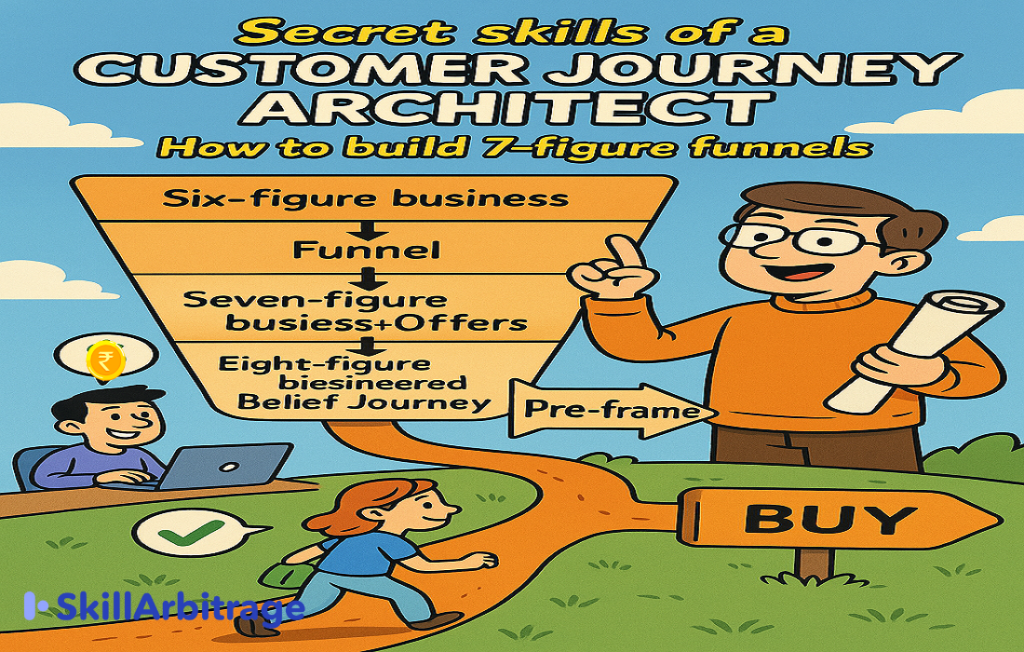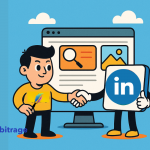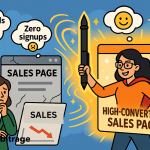This article is for freelance copywriters who are tired of guessing why their funnels aren’t converting. You’ll learn how Customer Journey Architects approach every funnel—how they pre-frame, qualify, and guide buyers through each stage with precision. By the end, you’ll know how to revive dead funnels, build 7-figure customer journeys without needing more traffic or better ads, and position yourself as a customer journey architect for your clients.
Table of Contents
Previously on Funnel Reverse Engineering…
Previously, Raja, Savitha, and Harsh cracked open the secret behind successful barefoot shoe launches by reverse engineering top funnels with Raghunandan’s help. Now, with the BareMode project in full swing, they’ll learn how to guide customers step by step through the value ladder, not just to sell but to build long-term buying momentum.
(Continued…)
Neel Marathe stood barefoot on the cool cement floor of BareMode HQ, loading camera batteries into his rucksack. Chalk dust from yesterday’s shoot still clung to his palms. In 48 hours, he’d be on a mountain trail in Machu Picchu, part of an invite-only Athleisure Founders Expedition. A mix of hiking, climbing, and founder-led brand storytelling. Each founder would be shooting content in brutal conditions, proving they lived what they sold.
Neel’s content would double as a product test, a customer trust builder, and a warning shot to competitors. But before vanishing into the Andes, he had unfinished business with his team.
Raja, Savitha, and Harsh sat across from him, confident, proud, and wrong.
“Good launch,” Neel said, tossing a power bank into his pack. “Congrats on figuring out how to copy a funnel.”
Raja frowned. “We didn’t copy. We modeled what worked.”
“Same thing,” Neel said. “You borrowed someone else’s road and got lucky the terrain matched.”
Harsh shrugged. “It worked. Good ROAS. Low CAC. Positive reviews.”
Neel zipped his bag shut.
“You don’t get paid to launch a funnel. You get paid to change someone’s default behavior. That didn’t happen.”
Savitha leaned forward. “So what did we miss?”
Neel grabbed a chalk marker and pointed at the whiteboard. “You built a pipe. What I need is a path. There’s a difference.”
He wrote:
Six-figure business → Funnel
Seven-figure business → Funnel + Offers
Eight-figure business → Engineered Belief Journey
“Here’s the line nobody tells you,” he said. “It’s not the product. Not the traffic. Not even the copy. It’s how well you pre-frame the next step in the journey. Every page. Every video. Every conversation.”
Raja squinted. “What do you mean by pre-frame?”
“I mean this,” Neel said. “If the prospect isn’t mentally ready for the next step before it happens, you lose. If the upsell feels like a jump instead of a bridge, you lose. If the testimonial page doesn’t resolve the specific doubt they had after checkout, you lose.”
He tossed the chalk at Harsh.
“Your funnel got sales. Great. But it didn’t build momentum. People bought one product. They didn’t want to buy again. That’s the real scoreboard.”
Savitha said, “So you want us to… map out what? Emotions?”
“No. I want you to architect belief. Step by step. What do they need to believe before buying a ₹4999 sandal? Before buying our ₹11,999 workshop? Before becoming a monthly subscriber? Lay it all out.”
Harsh muttered, “So you’re saying the journey is the offer.”
“No,” Neel said. “I’m saying the pre-frame is the offer. You win the sale one frame before the pitch lands.”
He walked over to the glass wall. Outside, the mountain trail poster flapped gently in the A/C breeze. Go Bare. Go Brutal.
“This brand is me,” he said. “Every customer journey is a mirror of the founder’s mindset. You know how I climb mountains? One false move ahead of the fall.”
He turned around. “I want you to build a customer journey for BareMode. One for first-time buyers. One for returning customers. One for subscription. From curiosity to obsession. Pre-frame every jump like a survival instinct.”
Raja said, “And you’ll review it when you’re back?”
“No,” Neel said. “I’ll climb with it. The Andes are my focus group. If I believe it up there, barefoot and freezing, then our customers will believe it down here.”
Savitha raised her brow. “And if not?”
Neel grinned. “Then you’ll know where you missed the next step.”
Pre-Framing
Raja scribbled on the whiteboard, mumbling to himself. “Pre-framing… like warming up the room before the pitch?”
Neel walked over and underlined the word before.
“Close,” he said. “But not warm. Sharp. Pre-framing isn’t just about setting mood. It’s about setting angle. Making sure they show up thinking exactly what you want them to think.”
Savitha said, “So it’s not about the product?”
Neel shook his head. “It’s about what version of themselves they show up as.”
He pointed at the funnel diagram on screen.
“Look…Facebook ad, Google ad, VSL, lead magnet. All of these are pre-frames. They don’t just drive traffic. They decide how the buyer lands. A Facebook ad might spark curiosity. A Google ad hits when they’re actively searching. A VSL builds belief. A lead magnet makes them feel like they’ve already won something.”
He tapped the screen.
“If they land with doubt, even a perfect page dies. But if they land feeling informed, understood, and a little proud of themselves? The sale’s already halfway done.”
He pulled up BareMode’s analytics on the big screen.
“Same traffic. Same funnel. But two different emails sent before. One made them feel smart for choosing barefoot. The other made them feel scared of foot damage.”
He pointed.
“Guess which one converted higher?”
Harsh blinked. “Fear?”
“Nope. Pride. Because it didn’t just pre-frame the product. It pre-framed identity. The reader showed up already wanting to feel like the kind of person who outsmarts modern footwear lies.”
He clicked to the ad dashboard. One ad had Neel, barefoot on a wet mountain trail, holding up a mass-market sneaker sole cracked in half. Caption:
Wore this for one week. My knee’s still mad at me. Know what your shoes are really doing to you?
It didn’t push the product. It pushed a question. Stirred doubt. So by the time they clicked, they weren’t browsing. They were investigating. The landing page didn’t convince them. It confirmed what they already suspected.
Raja leaned back. “So… the real funnel starts before the funnel.”
“Exactly,” Neel said. “The frame before the click matters more than the page itself.”
He pointed at the chalkboard again.
“Map it out. Every click. Every scroll. Every doubt. Pre-frame it.”
Want to continue into how different traffic sources shape different pre-frames?
Traffic temperature dictates the pre-frame
Neel grabbed a marker and drew three stick figures on the whiteboard: one smiling, one neutral, one with a raised eyebrow.
“Here’s the part most marketers butcher. They build one funnel, one message, one entry point, and forget the people walking in aren’t the same.”
He labeled the smiling one: Hot.
The neutral: Warm.
The skeptic: Cold.
“You can’t talk to all three the same way. Hot traffic already knows, likes, and trusts you. They don’t need a long story. A direct link in an email, a quick podcast mention, or a product update and done.”
Raja nodded. “That’s what we’ve been doing for repeat customers.”
“Exactly,” Neel said. “But now BareMode’s growing. You’ll need to talk to people who don’t follow us yet but trust someone who does. Warm traffic. Maybe they see a collab reel with an athlete. Or an influencer wearing our shoes during a hike. You’re borrowing trust.”
He pointed to the neutral stick figure. “For them, give a short video. Or an endorsement that makes them feel like we’re already in their world.”
Harsh frowned. “And cold traffic?”
Neel slapped the board under the skeptic. “Cold traffic is allergic to sales. They’ve never seen us. Don’t know who I am. Don’t care about barefoot anything. If we sell too soon, we lose them.”
Savitha said, “So we educate first.”
Neel smiled. “Educate. Entertain. Reframe. Make them feel like they discovered us. That’s your longest bridge. A story-driven lead magnet. A short film. An eye-opening article.”
He turned to face all three.
“You don’t get to choose your traffic temperature. But you do get to choose how warm they feel before they hit your page.”
He stepped back, arms crossed.
“Your job isn’t to build a funnel. It’s to meet people at the temperature they’re already at, and raise it just enough to move.”
Savitha glanced at Harsh. “So a cold Facebook ad needs way more than a hot email blast.”
“Now you’re getting it,” Neel said.
He circled all three figures.
“One product. Three roads in. Each with a different tone, length, and intent. Pre-frame isn’t just a tactic. It’s customer psychology in motion.”
He paused.
“Map every step of BareMode’s product lines with that lens. When I get back from Machu Picchu, I want to see those roads laid out. Each one clear. Each one clean. Each one warmed to the point of no return.”
Neel turned to Harsh. “You’re the email guy. Tell me, what’s your plan for cold traffic?”
Harsh hesitated. “Uhh… maybe we run a sale? Like a launch discount?”
Neel sighed and walked to the window.
“You think a guy scrolling Instagram at 11:48 p.m. with greasy thumbs, watching fail videos, is gonna see a SALE ON BAREFOOT SHOES ad and suddenly abandon socks for life?”
Harsh said nothing.
“No. He’s gonna think, ‘Weird hippie brand.’ Then scroll.”
Raja chimed in. “So what would you show him?”
Neel spun back. “A story. Not a sale.”
He grabbed a notepad and scribbled:
‘I ran 6km with a pebble in my shoe and didn’t even feel it. Here’s why.’
“This is your ad. Short selfie-style video. I talk about how barefoot shoes rewire your posture. Mention a doctor who backs it. Maybe show my X-ray from before and after. That’s the hook.”
He underlined it. “Then we invite them to download our ‘5-Day Foot Reset,’ a simple, free guide to test barefoot living without spending a rupee.”
Savitha raised an eyebrow. “So the ad sells the guide, not the shoe.”
“Exactly,” Neel said. “The ad pre-frames the guide. The guide pre-frames the shoes. Step by step, like warming up cold toes under a blanket.”
He looked at them all.
“Cold traffic isn’t convinced. They’re curious. You can’t convert curiosity with a coupon. You convert it with clarity. With confidence. With control of their internal dialogue.”
Raja was scribbling fast. “That’s our job now.”
Neel nodded. “No one’s buying shoes. They’re buying a new relationship with their body. And that relationship starts cold. Your funnel has to make it warm.”
The 7 Phases of a Funnel (with Key Jobs at Each Stage)
Neel wiped the whiteboard clean with his sleeve and drew a horizontal line.
“This,” he said, “isn’t just your funnel. It’s your buyer’s mental journey. You’re not setting up buttons. You’re syncing with what’s going on in their head.”
Savitha crossed her arms. “I’m going to need you to explain that like I’m five.”
Neel smirked. “Perfect. Let’s go phase by phase.”
Phase 1: Determine traffic temperature
He drew three stick figures.
“One is already a fan. One heard about us through a friend. One’s never seen us before.”
Harsh chimed in. “So hot, warm, cold?”
“Exactly,” Neel said. “If someone clicks on an email from us, they’re hot. If they see our post on a physiotherapist’s page, they’re warm. If it’s a random Facebook ad, they’re cold.”
Raja nodded. “So you don’t talk to all of them the same.”
“Bingo,” Neel said. “A hot lead doesn’t need a lecture. A cold one doesn’t need a pitch. Each type needs a different kind of handshake.”
He wrote on the board:
Right temp = right approach.
Phase 2: Pre-frame bridge
Neel drew a bridge between the stick figures and a shoe box.
“This bridge changes everything,” he said. “It’s how we set the tone before they see our offer.”
Savitha raised a brow. “Like a vibe check?”
“Exactly. You warm them up before they land. Watch.”
He ticked off examples with his marker:
- A short founder video about how he used barefoot shoes to fix his back pain.
- A quiz: “Is your foot strength aging faster than you?”
- A blog post titled Why Modern Shoes Are Killing Your Spine.
Harsh added, “Or a screenshot of a customer saying ‘I ran without knee pain for the first time in 6 years.’”
“Yes!” Neel said. “These are not sales pitches. They’re mental primers. They shift the question from ‘Should I buy this?’ to ‘Wait… why haven’t I heard of this before?’”
Phase 3: Qualify subscribers
He drew an email icon.
“Next,” he said, “we get them to raise their hand.”
Savitha said, “With a freebie?”
“Yup. But not a boring PDF. Something they’d brag about downloading.”
He wrote:
‘7 Barefoot Drills to Rebuild Your Arches in 7 Days’
‘Foot Strength Test: Are You Ready to Go Bare?’
“If 1,000 people hit that page and 300 sign up, you’ve got 300 warm leads. People who asked to hear from you.”
Phase 4: Qualify buyers
Raja tapped his notebook. “This is where most freelancers hesitate. Asking for money.”
Neel nodded. “Because they think it’s too soon. But if someone just said ‘Yes, I want better feet,’ now’s the time to strike.”
He drew a ₹ symbol and circled it.
“Offer a tiny product. ₹99 to ₹299. Not to make money. To find your serious buyers.”
Harsh said, “Like our Foot Strength Starter Kit.”
“Exactly. A mini video course, a stretch band, a checklist. Just enough skin in the game to separate window-shoppers from action-takers.”
Savitha raised a finger. “Why not just wait and sell the ₹3,000 shoe later?”
“Because,” Neel said, “people who buy early are 10x more likely to buy again. They’ve already crossed the line. They’re not shopping. They’re climbing.”
Phase 5: Identify hyperactive buyers
Neel drew a rocket. “Some people won’t just buy. They’ll binge-buy. These are your hyperactives.”
Savitha blinked. “That’s a thing?”
“Oh yeah. You’ll see the same name pop up: they downloaded the guide, bought the kit, grabbed the course, added a shoe, and asked if we ship to Ladakh.”
He grinned.
“Don’t make them wait. Show them more immediately. A bundle of 2 shoes. A ₹799 rehab series. A VIP call with our physio. Upsells, downsells, cross-sells. Stack the table.”
He wrote:
Strike while the credit card’s hot.
Phase 6: Age and ascend the relationship
“Now,” Neel said, “we don’t go bigger. We go deeper.”
He leaned in. “This is where 90% of freelancers blow it. They treat funnels like ATMs. Add more upsells. Hike the prices. But that’s not a ladder, it’s a trap.”
Raja said, “So what do we do?”
Neel replied, “Build trust. Slowly. Strategically. Make them feel like insiders.”
He wrote a weekly flow:
- Week 1: “Congrats on joining BareMode. Here’s how to break in your shoe.”
- Week 2: “Behind the scenes: Why our founder still runs barefoot at 41.”
- Week 3: “Introducing the 3-Month Transformation Plan.”
- Week 5: “We’re launching a retreat in Goa. You in?”
Savitha smiled. “You’re not escalating price. You’re escalating confidence.”
“Exactly,” Neel said. “And when you speak to them again, don’t go back to ‘Hey there!’ You say, ‘You already know why we do this. Now here’s what’s next.’”
Phase 7: Re-engage past buyers
Raja pointed to the board. “What about people who drop off after the first product?”
Neel circled back. “They’re not gone. They’re just waiting for a reason to come back.”
He listed ideas:
- Send them a story of someone their age who reversed plantar fasciitis.
- Ask them to vote on our next shoe color.
- Offer them a ‘Legacy Edition’ if they were among the first 100 buyers.
- Invite them to join a referral circle for early access.
“Talk to them like old friends,” Neel said. “Not like strangers.”
He stepped back from the board.
“This funnel isn’t a sales trap. It’s a trust timeline. Get that right, and you won’t need to ‘launch’ every time. People will just keep climbing.”
Neel slung his battered rucksack over one shoulder and checked the time.
“Alright, I’ve got 12 minutes to make it to the airport, or I miss the last flight to Lima.”
Savitha looked up. “You’re really going to Machu Picchu mid-launch?”
“I launch. You guys fix,” he grinned. “That’s how BareMode works.”
Raja laughed, but Harsh was already pacing with a notepad. “Wait, before you go. Do you want us to rewrite the email stack or just reorder…”
“Surprise me,” Neel said, walking backwards toward the door. “Whatever gets the next 1000 pairs sold.”
He paused for a beat and turned serious. “You’ve got the old funnel. You’ve got the new hooks. Don’t overthink it. The market rewards clarity, not cleverness.”
Then, with a wink, he added, “Launch loud. Sell sharp. Fix later.”
And just like that, he was gone.
Savitha turned to Raja. “Did he just leave his own launch in our hands?”
Raja shrugged. “That’s the game. If you can’t ghostwrite someone’s chaos, you’re not a specialist.”
They got to work.
(To be continued…)







 Allow notifications
Allow notifications
